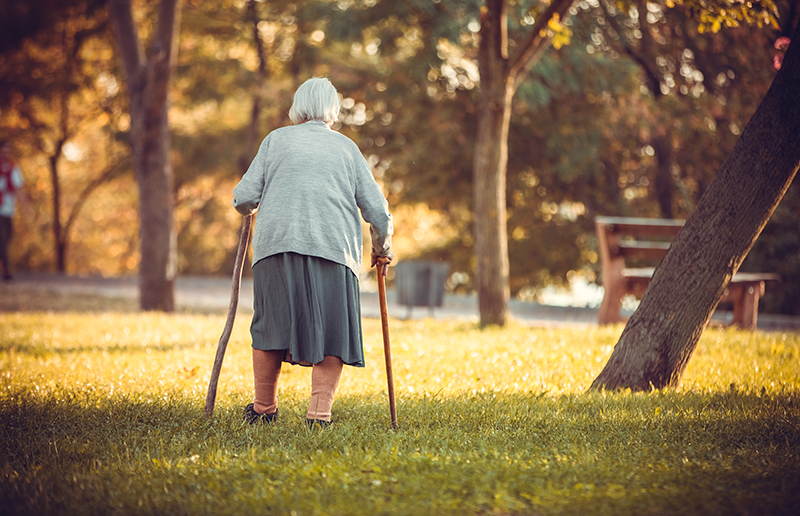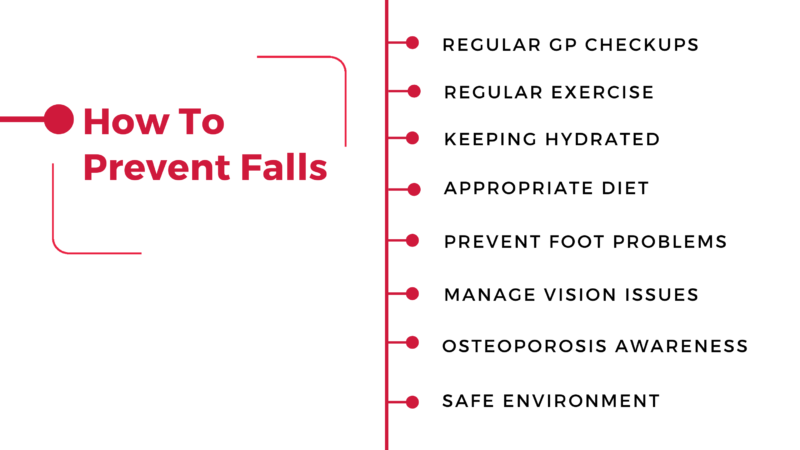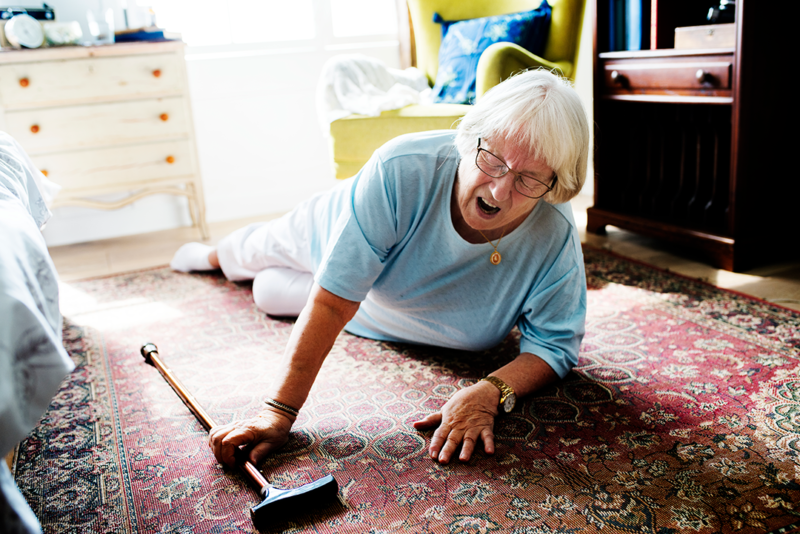As our Mums and Dads age, one thing we should be vigilant about is the potential for falls. The statistics tell the story, with about 30 per cent of adults over the age of 65 having at least one fall per year, that’s one in three older adults.
Falls are the leading cause of injury-related admission to emergency departments for seniors. This may be due to various reasons related to our ageing bodies, including weaker muscles, poorer vision or fainter hearing. While this may seem inevitable, fall prevention is possible and so is avoiding the injuries, and loss of quality of life they cause.
Here are some risk factors that can increase the chances of falling in older adults:
- Muscle weakness – As we age, we start to lose muscle mass and strength, particularly in the lower legs. This can make daily tasks more difficult, leading to falls.
- Loss of balance – With the loss of muscle strength, balance and co-ordination may be impaired. This may lead to accidental trips and falls. Research has found that loss of balance can increase the risk of a fall by four to five times.
- Physical inactivity – While it may be tempting to relax in your retirement, not being active can lead to muscle weakness and loss of balance.
- Poor vision – Changes in vision can contribute to falls. Difficulty seeing where you are walking or knocking into a cupboard you didn’t see are some of the ways in which older adults fall. Vision problems may double the likeliness of a fall.
- Cognitive impairment – Being confused, which is common with dementia or delirium, can also increase the risk of falls, especially when there are a lot of distractions such as bright colours or loud sounds.
- Footwear – While high heels may seem the ideal fashionable option for your favourite outfit, they can be uncomfortable and even lead to falls! Any footwear that fits poorly, has worn-out soles, or has open heels may increase the risk of falls.
- Medication – Specific medicines, or the effects different medications have on each other, are known to increase the risk of falls. Make sure to discuss this with your doctor if you are concerned.
- Dizziness – This can be caused by a variety of factors including vertigo, medication or a drop in blood pressure when you stand up. This can lead to falls. If you do experience dizziness, it is important to investigate this further with your doctor.
- Malnutrition – Inadequate nutrition may have an effect on the way our bodies work. This change in function may lead to falls. Therefore, it is important to have a balanced diet as we age.
- Past history of falls – This is the greatest indicator for future falls, which is why it is important to know the cause of falls when it happens and whether anything can be changed to prevent future occurrences.
- Fear of falling – Falls can be frightening! However, the fear of falling can be a contributory factor as lack of confidence may lead to an avoidance of movement. This in turn leads to muscle weakness and loss of balance.
Many of the risk factors above can be addressed, so it’s important to get some help and reduce the risk of falls as much as possible.

Fall prevention – What actually works to minimise falls
Falls are known to be the leading cause of injuries among the elderly. Statistics show that one in ten falls results in a serious injury requiring hospitalisation.
At times, people may need a year to recover from such injuries and may need to stay at a long-term care facility. Therefore, it’s critical that seniors (and their family members) are aware of ways to minimise falls.
Evidence suggests that a multi-factor approach that targets individual risk factors for falling is the best way to reduce falls. This multi-disciplinary approach, to identify and minimise an individual’s risk factors, may include a GP, physiotherapist, occupational therapist, nurse, pharmacist, podiatrist, optometrist and dietitian.
There are eight specific fall prevention strategies; you might adopt all or some of them.

1. Regular check-ups with a GP
Have regular check-ups with your doctor to ensure your medical conditions are well managed. Discuss any concerns early to avoid these becoming bigger problems. If suitable, get involved with some support groups. Keep a list of all your prescription and non-prescription medicines, and always take this to any appointments with doctors.
Talk to your doctor if your health problems or pains are stopping you from attempting exercise.
2. Regular exercise.
Our bodies are designed to move. Physical activity keeps us healthy and reduces the risk of falls. It also helps to improve balance, improve muscle strength and flexibility. Some examples of fall prevention exercises that can be undertaken are Tai Chi, dancing or group exercise programs that include balance and muscle strengthening.
Talk to a physiotherapist about which balance and strengthening exercises or activities will best suit you, and how to manage any pain you might have.
A physiotherapist can also advise you about whether a walking aid, such as a stick or frame, would help you. Using a walking aid can increase your steadiness and confidence to walk more. It is important that walking aids are properly adjusted for you, and that they are properly maintained.
3. Keep hydrated
Several studies have shown that those who drink adequate water have healthier minds, which is especially important as we get older, as cognitive abilities can often slow down as we age. Even mild dehydration can impact the brain’s ability to function to its full potential.
Research has shown that exercise is much easier for those who are well-hydrated. Drinking enough water can improve our endurance levels, lower the heart rate and speed up the recovery process of physical activity. This in turn reduces the risk of falls.
4. Appropriate diet.
It is very important to eat a wide variety of foods. A nutritious diet and at least 30 minutes of exercise a day can contribute to a higher quality of life through improved bone and muscle health, increased mental alertness and improved resistance to illness and disease. A balanced diet with enjoyable and varied food, including plenty of fruit and vegetables, fibre and vitamins, can do wonders, along with keeping well hydrated and getting enough sleep.
Vitamin D and calcium supplements are recommended as an intervention strategy to prevent falls in older people who live in the community, particularly if they are not exposed to the minimum recommended levels of sunlight. Benefits from supplements are most likely to be seen in people who have vitamin deficiencies.
5. Prevent foot problems.
As we age, our feet can change shape and lose some feeling and flexibility. This changes the way we walk and affects balance. Painful or swollen feet can make it difficult to walk. Also, some shoes or slippers can make it more likely to slip, trip or stumble, leading to a fall.
See a podiatrist or doctor if you have painful or swollen feet, tingling, or pins and needles in your feet, or if you have any changes in the shape of your feet (for example, bunions).
To avoid falls, choose comfortable, firm-fitting, flat shoes with a low, broad heel and soles that grip. Don’t wear poorly fitted slippers and don’t walk in socks.
6. Manage vision issues.
Your eyes not only allow you to see obstacles and judge steps, but they also help you to keep your balance. Keep your glasses clean and always wear the correct glasses – reading glasses are for reading and distance glasses are for walking around.
If you notice changes in your eyesight, make an appointment with your doctor or optometrist. It is recommended to have your eyesight and glasses checked by an optometrist at least once every two years and annually by your doctor.
7. Osteoporosis awareness.
People with osteoporosis (weak or thin bones) are more likely to break a bone from a fall than those with healthy bones. If you have osteoporosis, your doctor may advise calcium and vitamin D tablets, other medicines, exercise or dietary changes.
Talk to your doctor about how to keep your bones strong. This may involve some dietary changes such as eating more calcium-rich foods, exercise and increasing your exposure to sunlight. A physiotherapist can help with appropriate and safe exercises to strengthen your muscles and your bones.
8. Safe environment.
As an immediate step towards fall prevention, always be aware of your surroundings and home set-up. Making your living space as safe as possible can reduce the likelihood of a fall, and will make it easier for you to manage your daily activities as you get older.
Be aware of your clothing. The risk of falls may be increased by wearing clothes or dressing gowns that are too long and loose, which can catch on things. Unsafe footwear, such as loose slippers or narrow heels, slippery surfaces such as wet or polished floors, or spills of food or liquid, can all create an unsafe environment.
You may choose to remove mats and rugs, or at least ensure they are well secured. Get rid of mats that curl, slide or fold over easily. Use a handrail or a seat in the shower or bath. Other common problem areas are poor lighting, trip hazards such as steps, slippery surfaces and structural hazards around the house.
An occupational therapist can help to assess the home environment for specific environmental or equipment needs and assist with training to maximise safety.
If you are considering The Physio Co and would like more details on our approach, please feel free to reach out for a chat – we are just a phone call away: 1300 797 793.



 1300 797 793
1300 797 793